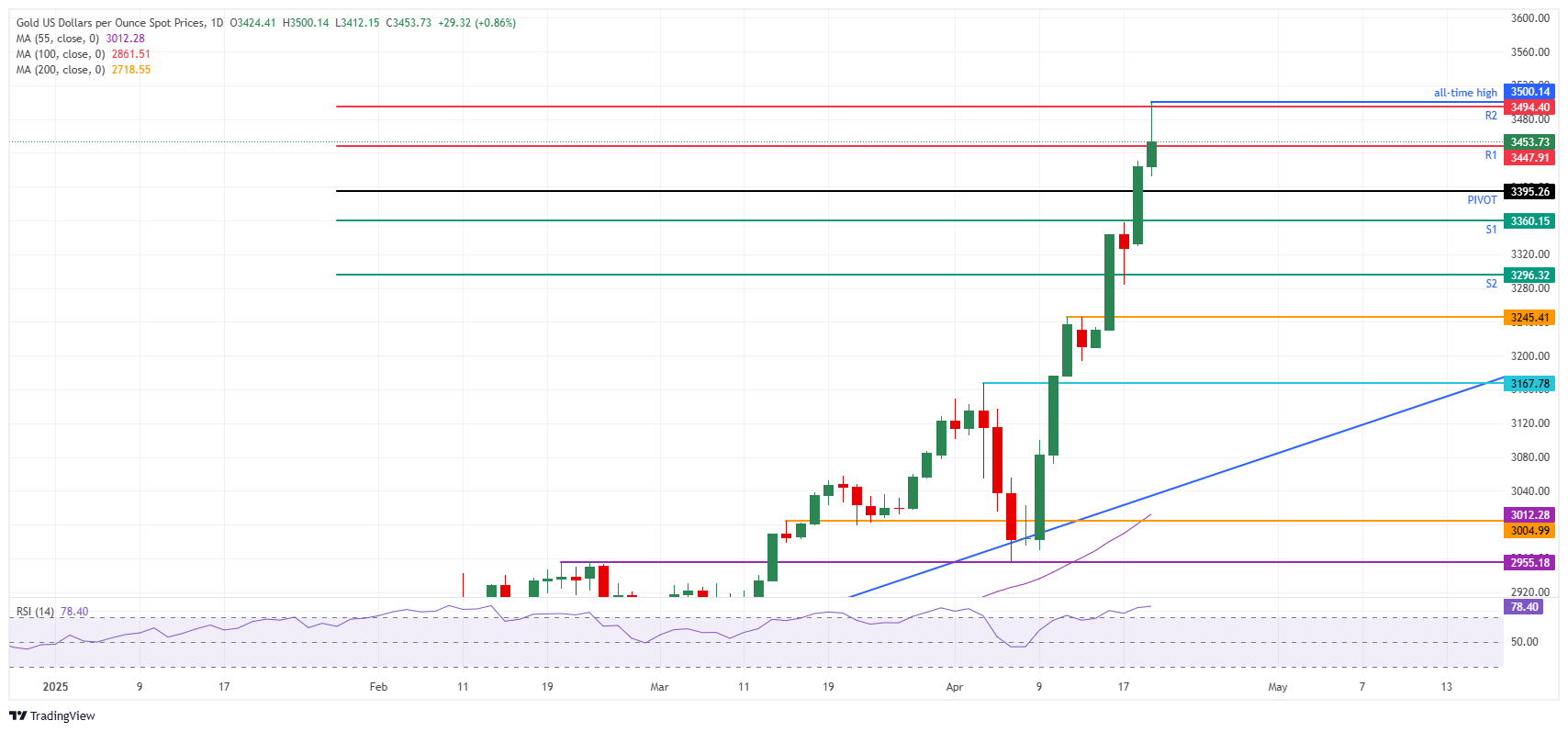Gold price up over 10% in April, hits $3,500 on Fed spat turmoil
- Gold price rockets higher and sprints to $3,500, booking over 10% gains in April thus far.
- US President Trump issued harsh rhetoric against Fed Chairman Powell on his rate policy.
- Markets are unstable due to equity earnings season uncertainty and the US political crackdown on the Fed.
Gold price (XAU/USD) shows no signs of fatigue and extends its rally higher yet again, hitting another record high at $3,500 in early Asian trading on Tuesday. However, price action is cooling off a bit, and Gold dips back to around $3,460 at the time of writing due to some profit taking at the psychological level. Several markets across the globe are returning to normal trading regimes after the holiday-infused Easter price action, with Good Friday and Easter Monday seeing reduced trading volumes due to bank holidays.
This week’s rally is being fueled by mounting uncertainty and pressure on the independence of the Federal Reserve (Fed) and its Chairman Jerome Powell. United States (US) President Donald Trump has been blaming the Fed and its Chairman for the still-elevated interest rates. Trump accused Fed Chairman Powell of lowering rates during Joe Biden’s presidency and said to be looking at any means or possibilities to have the Chairman replaced by Trump’s pick to get US rates slashed quickly.
Daily digest market movers: Jefferies issues guidance
- US President Trump’s call on the Fed to cut interest rates immediately is seen by several traders and market participants as a threat to the central bank’s independence that drove the US Dollar to its lowest since 2022 in the US Dollar Index (DXY), Bloomberg reports.
- Gold may be “the only true safe-haven asset left” as investors question US assets, including Treasuries, according to Jefferies. “With the recent selloff in US Treasuries, and a view that Treasuries are inextricably tied to tariffs, a trade war with China, and the US fiscal situation, we believe gold is the only true safe-haven asset left,” Jefferies analysts said in a note on Tuesday, Reuters reports.
- Ahead of quarterly earnings, and based on fundamentals, Jefferies highlighted as preferred picks Endeavour Mining Plc among seniors, and Dundee Precious Metals Inc. among non-seniors, Bloomberg reports.
Gold Price Technical Analysis: Gold rally to consolidate gains again
The precious metal is heated, maybe overheated, after hitting a fresh all-time high yet again in April. As if the trade war uncertainties and domestic political spats in the US were not enough to fuel the Bullion rally, the fact that the US President is willing to pick a fight with the Fed and is looking for ways to have its credible Chairman removed from office is probably the final straw for markets.
The intraday R2 resistance at $3,494 has already been tested, and Gold has hit a fresh all-time high at $3,500 on Tuesday before correcting slightly lower. This makes these levels a double resistance zone from now on. Should the Gold price close above the R1 resistance at $3,447 on a daily basis, more all-time highs and gains for April could still occur.
On the downside, the daily Pivot Point comes in at $3,395, though that looks bleak with no real technical support nearby. Instead, the S1 support at $3,360, which roughly coincides with the April 17 high, is a more logical support to look at. In case that level breaks, look for the S2 support at $3,296 and the April 11 high at $ 3,245 on the downside.

XAU/USD: Daily Chart
Gold FAQs
Gold has played a key role in human’s history as it has been widely used as a store of value and medium of exchange. Currently, apart from its shine and usage for jewelry, the precious metal is widely seen as a safe-haven asset, meaning that it is considered a good investment during turbulent times. Gold is also widely seen as a hedge against inflation and against depreciating currencies as it doesn’t rely on any specific issuer or government.
Central banks are the biggest Gold holders. In their aim to support their currencies in turbulent times, central banks tend to diversify their reserves and buy Gold to improve the perceived strength of the economy and the currency. High Gold reserves can be a source of trust for a country’s solvency. Central banks added 1,136 tonnes of Gold worth around $70 billion to their reserves in 2022, according to data from the World Gold Council. This is the highest yearly purchase since records began. Central banks from emerging economies such as China, India and Turkey are quickly increasing their Gold reserves.
Gold has an inverse correlation with the US Dollar and US Treasuries, which are both major reserve and safe-haven assets. When the Dollar depreciates, Gold tends to rise, enabling investors and central banks to diversify their assets in turbulent times. Gold is also inversely correlated with risk assets. A rally in the stock market tends to weaken Gold price, while sell-offs in riskier markets tend to favor the precious metal.
The price can move due to a wide range of factors. Geopolitical instability or fears of a deep recession can quickly make Gold price escalate due to its safe-haven status. As a yield-less asset, Gold tends to rise with lower interest rates, while higher cost of money usually weighs down on the yellow metal. Still, most moves depend on how the US Dollar (USD) behaves as the asset is priced in dollars (XAU/USD). A strong Dollar tends to keep the price of Gold controlled, whereas a weaker Dollar is likely to push Gold prices up.

